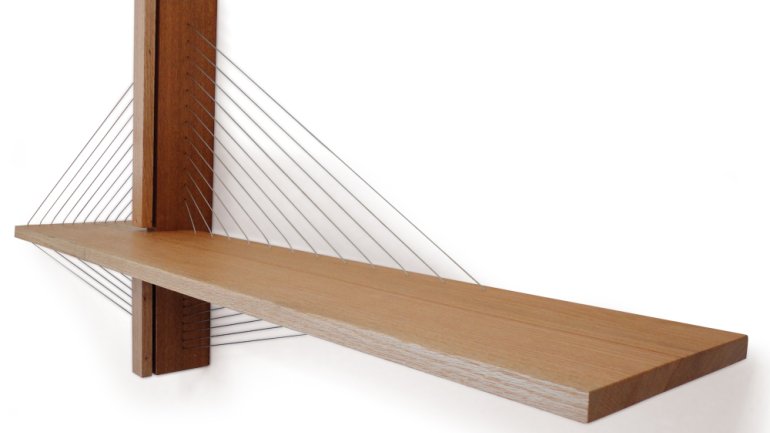Cable Provider
Cable Provider
When Robby Cuthbert began adapting the structural dynamics of the cable-stayed bridge to such domestic creations as lamps and shelving, he was inspired more by, say, cross-country skiing than any obsession with engineering.
“One of my professors was explaining how opposing muscle groups – like the biceps and triceps – have to work in tandem for maximum performance, and that started me thinking about the tensile properties of cable,” Cuthbert says. “Some cables push surfaces closer together, others pull them apart – as with muscles, the challenge is striking just the right balance.” After his mini-epiphany, Cuthbert began using sculpture as a means of exploring his fascination with tensional methods. (It comes as no surprise that he is an admirer of architect Santiago Calatrava, who has employed the technology on a larger scale with projects such as the Milwaukee Art Museum.)
After graduating from Williams College, where he studied sculpture and architecture, Cuthbert, 25, began casting about for more practical applications for his passion. “I tend to like things that are useful,” he says. “And furniture is like functional sculpture. Now I sculpt to generate ideas – it’s like sketching in plywood.”
One of Cuthbert’s first pieces to stand on its own was an early version of his glass-topped Contour coffee table, whose bamboo base is composed of four sinuous overlapping curves that never touch. “It had a slight wobble and took me a year to fine-tune.” Thin steel filaments, rather than adhesives or fasteners, support the mahogany swoosh of his Signature lamp. And the cantilevered oak plank of the Suspension shelf appears to float away from its mahogany spine, supporting up to 45 pounds of books and tchotchkes with little visible means of support.
By the way, that embedded word “suspense” is not accidental: “I am intrigued with creating furniture that contains a bit of an enigma – some visual uncertainty,” Cuthbert admits. “It’s part of the fun.”
Cuthbert credits a Kickstarter campaign for his relatively quick transformation from student artist to entrepreneur; it bought him valuable time to tinker while ramping up demand for goods. And moving across the country to Palo Alto, California, when his girlfriend got a job in the area was a serendipitous boon. He does production at the nearby community-based TechShop — “It’s like a full-service gym for the maker community” – which offers wood and metal shops, laser cutters, 3D printers, and the CNC router that cuts out the curvy shapes he favors more efficiently than hands ever could.
While Cuthbert has eight designs in production, many more ideas and one-offs are featured on his website.
His take on the classic Adirondack chair, for example, conveys all the nostalgia of the beloved profile but with a twist: The cedar seat is completely suspended by cables and never touches the frame. The bamboo sculptural desk chair was commissioned by a client who favored structure and aesthetics over ergonomics, with echoes of de Stijl and Gerrit Rietveld in its clean profile.
Cuthbert, who has been making and building things since childhood, has a long list of furnishings he’d like to try out, including a more affordable chair, an end table, and a floor lamp; and he is on the hunt for an assistant. “I have so many ideas; I just need to catch up first!”
Deborah Bishop is a writer in San Francisco and a frequent contributor to American Craft.




